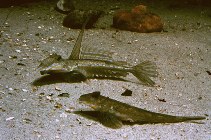| Family: |
Callionymidae (Dragonets) |
| Max. size: |
30.5 cm TL (male/unsexed); 25 cm TL (female); max. reported age: 7 years |
| Environment: |
demersal; marine; depth range 1 - 440 m |
| Distribution: |
Eastern Atlantic: southern Iceland and Norway south to Mauritania, including the northern Mediterranean, Gibraltar, and Algeria, western Black Sea, Aegean and Adriatic Sea, Azores and the Canary Islands. |
| Diagnosis: |
Dorsal spines (total): 4-4; Dorsal soft rays (total): 8-10; Anal soft rays: 9-9. Gill opening dorsal. Usually antrorse (forward-pointing) tip at base of preopercular spine. Rays of second dorsal unbranched except for the last, which is divided at base (Ref. 232). Snout length 2-3 times the diameter of the eye (Ref. 35388). |
| Biology: |
Occurs on sand and muddy bottoms from sublittoral to 200 m (Ref. 6444) and to 400 m or more (Ref. 9900). Feeds on small invertebrates, mainly worms and crustaceans. Territorial, males aggressive with each other. Complex courtship behavior consists of 4 phases: courtship, pairing, ascending, releasing eggs and milt. Pelagic eggs and larvae (Ref. 5968). Minimum depth reported from Ref. 27115. Neither opercular spine gland nor anterolateral glandular groove with venom gland is present (Ref. 57406). |
| IUCN Red List Status: |
Least Concern (LC); Date assessed: 06 May 2013 Ref. (130435)
|
| Threat to humans: |
harmless |
Source and more info: www.fishbase.org. For personal, classroom, and other internal use only. Not for publication.

